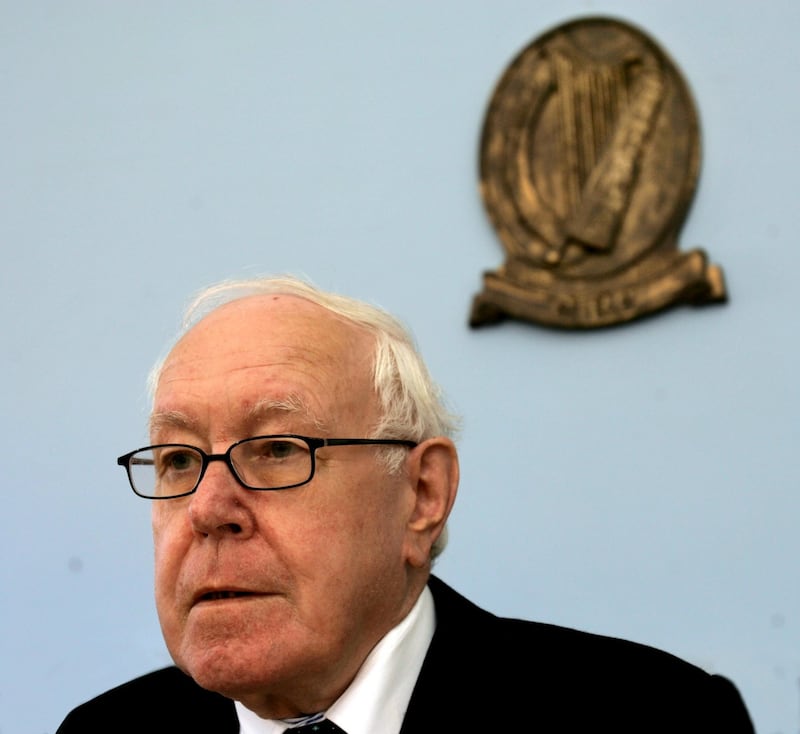Born: February 15th, 1937
Died: March 8th, 2022
0n his retirement as president of the District Court in 2005, Peter Smithwick, who has died in Kilkenny aged 85, was nominated as a one-man tribunal to enquire into alleged Garda collusion in the murder in 1989 of two RUC officers returning from a meeting at Dundalk’s Garda station. Assisted by an able team of barristers, who carried out a meticulous search for information prior to the oral hearings, the inquiry ran on for nine years. At one point then minister for justice Alan Shatter made an attempt to cut its deliberations short.
Smithwick saw him off, accusing him of inappropriate interference with the inquiry and went along at his own pace. The thorough and immaculately reasoned 400 page report, produced two years later, concluded on the balance of probabilities that there had been Garda collusion. However, it drew back fastidiously from concluding that the evidence linking the chief suspect with the IRA was sufficient to establish that he had colluded in the shooting of the two policemen.
Most damning was Smithwick’s indictment of the gardaí for their earlier efforts to cover up the collusion, which he said now made it more difficult to establish the facts; loyalty, he remarked, was prized over honesty. “Too often,” he concluded “the culture of failing adequately to address suggestions of wrongdoing, either for reasons of political expediency or by virtue of misguided loyalty, has been a feature of life in this State. This Tribunal has sought to establish the truth and, in so doing, I hope that it has contributed one small part to changing that culture.”
With characteristic courtesy, Smithwick met the families of the murdered policemen to acquaint them with the findings before they were published.
Prior to this, the Smithwick name was associated in public consciousness mainly with the brewery in Kilkenny, which dated from the early 18th century. As Catholics the family suffered the exclusions of the penal laws but were still able to prosper in business. Edmond Smithwick, a repealer and friend of Daniel O’Connell, was elected mayor of Kilkenny in 1843.
Kilcreene Lodge, the imposing family home near the city, was built in 1860. It was here that Peter Alexander Smithwick, born on February 15th, 1937, was brought up, the eldest son among seven children of Walter Smithwick and his English-born wife, Eileen.

Walter Smithwick, a flamboyant character who was a solicitor as well as a businessman, admired Seán Lemass and subscribed to Fianna Fáil, an allegiance that Peter espoused as a solicitor’s apprentice at UCD, where he went after school at Castleknock; he was a witty debater and an officer of the college’s famed literary and historical society.
Qualifying as a solicitor in 1961, Smithwick joined his father’s practice and became a non-executive director of the family brewery, which was taken over by Guinness in 1963. Bookish and never sporty, he involved himself in the local Butler Society and was active in the Irish Georgian Society. He followed his father into the Order of Malta, with whom he accompanied the sick over many years on their Lourdes pilgrimages. In later life he became president of the order’s Irish association.
As an eligible bachelor who was fun, Smithwick was much in demand in fashionable society. In 1974 he married Deirdre Cooper, the daughter of Cdr Cooper of Markree Castle in Sligo. When the couple’s occupancy of Kilcreene Lodge was cut short, they settled in the lovely village of Inistioge. Although their interests were quite different – she loved horses – it was a happy marriage, producing two daughters, one now a national teacher and the other a solicitor. Smithwick was a hands-on as well as an understanding father.
He was active politically as local director of elections for Fianna Fáil and was himself elected a member of Kilkenny City Council but could never persuade the local party to nominate him as a Dáil candidate. He was, however, on the influential National Executive of Fianna Fáil. Charles Haughey’s government appointed him a district justice in 1988; two years later he was promoted to become president of the District Court.
In short time, Smithwick proved his worth, silencing critics of his rapid promotion. He got the District Court upgraded by persuading the government to have its members designated as judges rather than justices, so banishing the impression that they were mere magistrates. Its president was accorded the status of a circuit court judge. Smithwick sat occasionally in that court and on the three-judge Special Criminal Court.
A stickler for standards, sartorial and otherwise, Smithwick commuted to the court from his home in Inistioge, cutting a figure as he walked purposefully from the railway station to the Four Courts wearing a bowler hat. Conscious that the District Court was the most frequented court in the land, Smithwick was determined to maintain its dignity and so inspire public respect for the justice system. He initiated the practice of District Court judges being gowned and put an end to informal hearings in their homes. He was renowned for his courtesy on the bench, even to criminals.
“This is preposterous,” he would exclaim, but the sentences he imposed were invariably lenient. He was protective of parents who fought to retain custody of their children.
For all his love of formality and the majesty of office, he never lost his lively sense of humour and relished a jest even at his own expense.
Final retirement came too late to fulfil plans to write a family history or a memoir of his friend and soulmate, the great Kilkenny liberal Hubert Butler. Until the Covid lockdown he was assiduous attending funerals, always donned in morning suit and top hat even after he had been confined to a wheelchair by a stroke.
Smithwick is survived by his wife Deirdre, his two daughters and five grandchildren. After Mass in Kilkenny’s Catholic Cathedral on March 11th he was buried in the family plot at St Canice’s Cathedral nearby.









